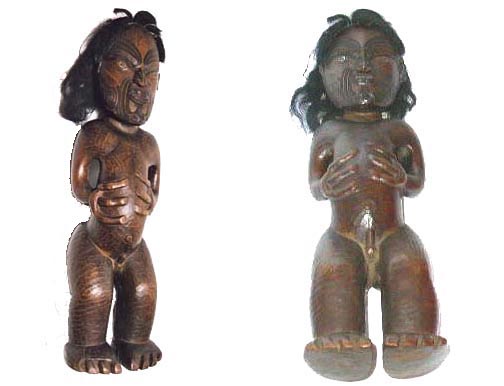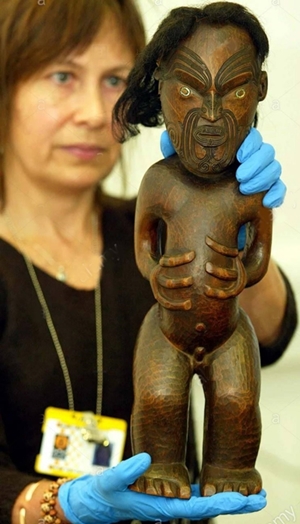The following is the catalogue description at Kelvingrove Museum in Glasgow.
A.1948.105 Freestanding carved Maori ancestor figure. New Zealand, 18th century. Sydney Folker
This carved male ancestor figure from the New Zealand Maori dates to the 18th century. Only six such Maori figures are known to exist. All are male, around 45 cm tall and all stand upright with hands resting on the belly. Other shared characteristics include the presence of male tattoos on the face and the attachment, or means for attachment, of human hair to the top of the head. There are few references to such figures in the accounts made by early European travelers to New Zealand, though in 1783 Crozet observed that '...in the middle of every village there is a carved figure which appears to represent the tutelary god of the village. In their private houses are to be found similar figures like little idols placed in positions of honour'.
It is probable that these carvings represented ancestral figures, whose role was to comfort and watch over their living descendents. They all date to the period before missionary activity. A midshipman called Samuel Folker brought this figure to Scotland around 1780. The Maori had been in regular contact with Europeans since Captain Cook's first visit in 1769, but these early encounters had only a limited effect on Maori beliefs and rituals. Christian missionaries arrived in 1814 and their influence increased steadily during the decades that followed. The missionaries thought the freestanding carved ancestor figures were idolatrous, unlike the ancestor figures incorporated into structures such as door lintels.
Carving used to be a sacred art, subject to rules and laws. The Maori believed that the gods communicated through master carvers. A master carver, observing very specific rituals and ceremonial restrictions would have made this figure. As with every carved Maori cultural treasure or taonga it would not only be decorative but would act as a record of tribal history and identity.
There are highly distinctive tattoo patterns incised on the figure's face, which may have been those of a specific ancestor. Its eyes are inlaid with oval rings of paua shell to give it the appearance of life. Human hair is attached through holes across the top of its head. Its hair is long enough to have been bound up in a topknot, a style characteristic of a warrior chief. The figure probably originally wore an earring as the left ear is pierced. The large three- fingered hands are spread over the abdomen, which the Maori believed was the centre of the body and the life force. The navel is given prominence as a raised circle because it was considered to be the link between living people and their ancestral spirits.
Top of page
 Photo 2
Photo 2
 Description
Description

